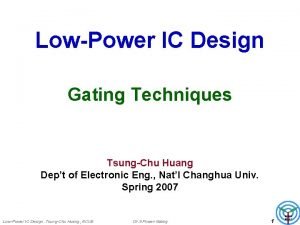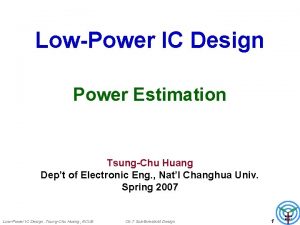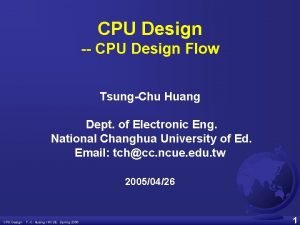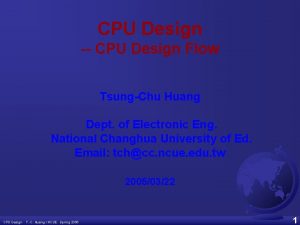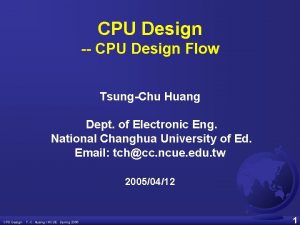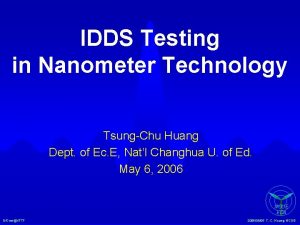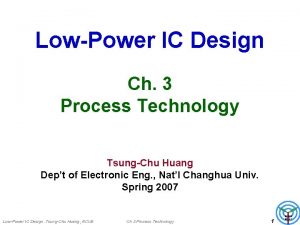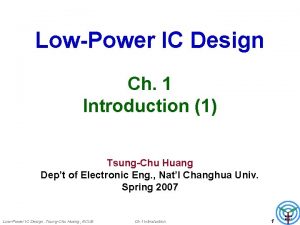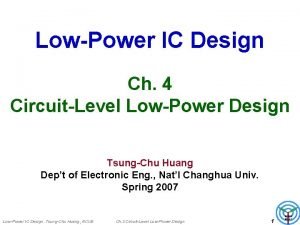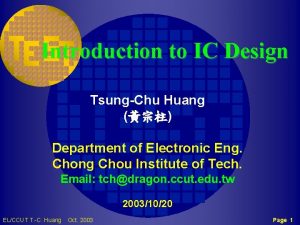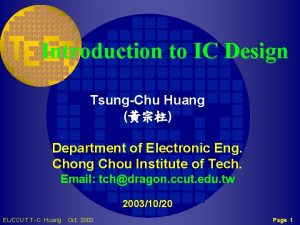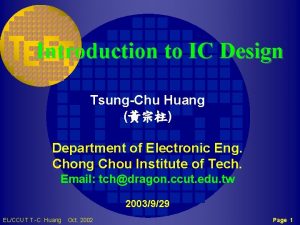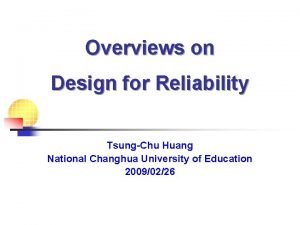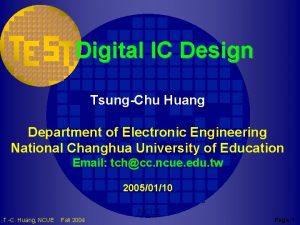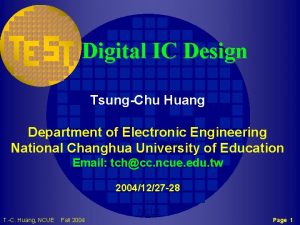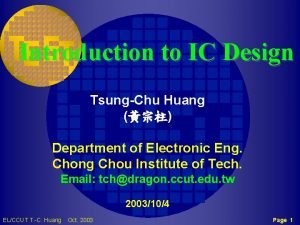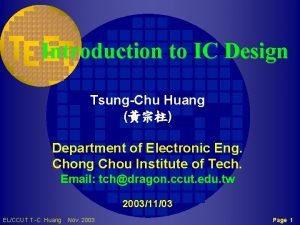LowPower IC Design LowPower Coding TsungChu Huang Dept

























- Slides: 25

Low-Power IC Design Low-Power Coding Tsung-Chu Huang Dep’t of Electronic Eng. , Nat’l Changhua Univ. Spring 2007 Low-Power IC Design. Tsung-Chu Huang, NCUE Ch. 10 Low-Power Coding 1 NCUE EDAT

Progress (Sub-)Systems Low-Power Testing (Combinatory) Algorithms Coding (Micro-)Architecture Power-Gating Logics Sub-threshold Design Circuits Low-Voltage Design Process Technology Modeling and Definitions Levels Parametric Modules Low-Power IC Design. Tsung-Chu Huang, NCUE Ch. 10 Low-Power Coding 2 NCUE EDAT

Outline Ø Classification Ø Material/Interface Ø Spatial/Channel/Fiber/Combinational/State/Audio/Image/Inst. /Bus etc. Ø Purposes/Goals Ø Volume/SNR/Detection/Encryption/Correction/Recovery/Power Ø Power Dissipation Model Ø Hamming Distance Ø Low-Power Bus/Channel Coding Ø 1 -1 Mapping Ø Gray Code Ø Many-to-one Coding Ø BI (Bus Invert) Ø SI (Shift Bus Invert) Ø X-filling Low-Power IC Design. Tsung-Chu Huang, NCUE Ch. 10 Low-Power Coding 3 NCUE EDAT

Typical Digital Communication System Format Source encode Channel encode Pulse modulate Bandpass modulate Digital demodulation Format Source decode Low-Power IC Design. Tsung-Chu Huang, NCUE Channel decode Ch. 10 Low-Power Coding Detect Channel Digital modulation Demod. Sample 4 NCUE EDAT

Power Dissipation Model for Channel Coding • Interconnection without Repeaters • Interconnection with Repeaters • As Inputs of Combinational Circuits – Hamming distances can be used to predict the switching activity of the combinational circuit. • Spread Spectrum Communication – Comparable to the white noise in the air. • 0 Watts Communication – Comparable to or less than the power dissipation in aerospace. Low-Power IC Design. Tsung-Chu Huang, NCUE Ch. 10 Low-Power Coding 5 NCUE EDAT

Thermodynamics Model • Entropy – Useless Energy. – Entropy is a function of a quantity of heat which shows the possibility of conversion of that heat into work. – δS = δQ / T • δQ is the amount of heat absorbed in an isothermal • T is the absolute temperature – In information theory an entropy encoding is a lossless data compression scheme that is independent of the specific characteristics of the medium. Low-Power IC Design. Tsung-Chu Huang, NCUE Ch. 10 Low-Power Coding 6 NCUE EDAT

Hamming Distance • Hamming distance is the sum of the bitwise differences between two vectors (codes or patterns). Low-Power IC Design. Tsung-Chu Huang, NCUE Ch. 10 Low-Power Coding 7 NCUE EDAT

Coding • Channel coding is done. . . – For detection and/or correction of errors produced by the channel (as block and convolutional coding) by • noise • interference • distortion – linear – nonlinear – To alleviate synchronization problems (as Manchester coding) – To alleviate detection problems (as differential coding) – To enable secrecy and security (as scrambling or ciphering) • But power dissipation in So. C Low-Power IC Design. Tsung-Chu Huang, NCUE Ch. 10 Low-Power Coding 8 NCUE EDAT

Coding Error detection /correction bits Message bits • Coding is classified to two flavors – source coding: makes transmitted bits equal probable maximizes channel capacity – channel coding: protects message & adapts it to channel • Channel coding means adding extra bits for message for error detection and/or correction • In systematic coding message bits remain the same in coded word: Low-Power IC Design. Tsung-Chu Huang, NCUE Ch. 10 Low-Power Coding 9 NCUE EDAT

Shannon’s Model NOISE CODING Source S Coded Bits DECODING Received Bits X Y Decoded Message T Channel symbols bits symbols • Shannon’s source coding theorem was that the source can be coded so that the number of bits per symbol is as close as we wish to the entropy of the source, but no less • Shannon’s channel coding theorem has to do with reducing the likelihood of errors in the presence of noise Low-Power IC Design. Tsung-Chu Huang, NCUE Ch. 10 Low-Power Coding 10 NCUE EDAT

Source and Channel Coding Noise Source Coded Bits S Received Bits X Y Decoded Message T Channel symbols bits Redundancy of source removed by compression (source coding) Low-Power IC Design. Tsung-Chu Huang, NCUE bits Error-correcting redundancy (channel coding) Ch. 10 Low-Power Coding symbols Message restored 11 NCUE EDAT

Shannon’s Channel Coding Theorem Source Channel Destination • For any channel there is a channel capacity, a certain number C of bits/second • As long as the source is producing less than C bits per second, messages can be coded so they will be received at the other end of the channel with arbitrarily low probability of error • If the source is producing bits at a rate higher than C bits/second, it is impossible to transmit bits with low probability of error Low-Power IC Design. Tsung-Chu Huang, NCUE Ch. 10 Low-Power Coding 12 NCUE EDAT

Source Coding and Channel Coding probability of error #bits /symbol source rate > channel capacity 0 entropy of source fancier source coding Low-Power IC Design. Tsung-Chu Huang, NCUE Ch. 10 Low-Power Coding source rate ≤ channel capacity fancier channel coding 13 NCUE EDAT

Huffman Coding – an entropy encoding algorithm used for lossless data compression. – a variable-length code table – Huffman tree generated from the exact frequencies – Example: “this is an example of a huffman tree” Low-Power IC Design. Tsung-Chu Huang, NCUE Ch. 10 Low-Power Coding Char space a e f h i m n s t l o p r u x Freq 7 4 4 3 2 2 2 1 1 1 Code 0111 0010 000 1101 1010 1000 0111 0010 1011 0110 11001 0110 10011 11000 0111 10010 14 NCUE EDAT

Low-Energy Bus Coding • An m-line bus with an average energy Em for transmitting any of 2 m words in Z={0, 1}m. • Usually, n=m+a lines are coded to reduce the energy, En < Em. Low-Power IC Design. Tsung-Chu Huang, NCUE Ch. 10 Low-Power Coding 15 NCUE EDAT

Reference Locality and Gray Code • • Reference Address (from 0~2 n-1, modulo 2 n) Locality = {p(next_address=address+1)>2 -n} Especially for instruction address Gray (Reflected Binary) Code Encoder/Decoder Q 5 Q 4 Q 3 Q 2 Q 1 Q 0 Low-Power IC Design. Tsung-Chu Huang, NCUE Ch. 10 Low-Power Coding 16 NCUE EDAT

Bus Invert (BI) Coding • If the transitions > ½ then invert them. Low-Power IC Design. Tsung-Chu Huang, NCUE Ch. 10 Low-Power Coding 17 NCUE EDAT

Bus Invert (BI) Coding Low-Power IC Design. Tsung-Chu Huang, NCUE Ch. 10 Low-Power Coding 18 NCUE EDAT

Shift-Invert (SI) Coding Low-Power IC Design. Tsung-Chu Huang, NCUE Ch. 10 Low-Power Coding 19 NCUE EDAT

Bus Coding considering Inter-Bus Cap Low-Power IC Design. Tsung-Chu Huang, NCUE Ch. 10 Low-Power Coding 20 NCUE EDAT

Heterogeneous No. C Architecture • A guided channel for Ser. Des based High Speed Serial Link Kangmin Lee. Low-power network-on-chip for high-performance So. C design. TVLSI 2006. Low-Power IC Design. Tsung-Chu Huang, NCUE Ch. 10 Low-Power Coding 21 NCUE EDAT

A Typical Ser. Des Low-Power IC Design. Tsung-Chu Huang, NCUE Ch. 10 Low-Power Coding 22 NCUE EDAT

• Synchronization structure in the No. C Low-Power IC Design. Tsung-Chu Huang, NCUE Ch. 10 Low-Power Coding 23 NCUE EDAT

Low Swing Signaling (Differential) Low-Power IC Design. Tsung-Chu Huang, NCUE Ch. 10 Low-Power Coding 24 NCUE EDAT

Round Robin Scheduler: Low Energy Coding Low-Power IC Design. Tsung-Chu Huang, NCUE Ch. 10 Low-Power Coding 25 NCUE EDAT
 Contoh axial coding
Contoh axial coding Contoh axial coding
Contoh axial coding Axial coding vs open coding
Axial coding vs open coding Coding dna and non coding dna
Coding dna and non coding dna Dept nmr spectroscopy
Dept nmr spectroscopy Fl dept of agriculture
Fl dept of agriculture Finance departments
Finance departments Worcester electrical inspector
Worcester electrical inspector Dept. name of organization
Dept. name of organization Mn dept of education
Mn dept of education Liz welch mississippi
Liz welch mississippi Dept. name of organization
Dept. name of organization Ohio employment first
Ohio employment first Dept. name of organization (of affiliation)
Dept. name of organization (of affiliation) Vaginal dept
Vaginal dept Gome dept
Gome dept Gome dept
Gome dept Gome dept
Gome dept Gome dept
Gome dept Hoe dept
Hoe dept Battalion chief interview questions
Battalion chief interview questions Maine department of agriculture conservation and forestry
Maine department of agriculture conservation and forestry Dept of education
Dept of education Florida dept of agriculture and consumer services
Florida dept of agriculture and consumer services Florida dept of agriculture and consumer services
Florida dept of agriculture and consumer services Dept a
Dept a


























